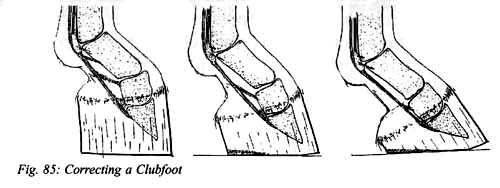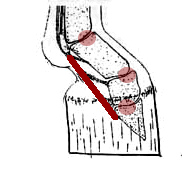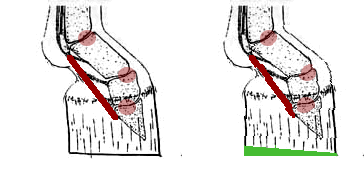Farriery Faux Pas
I'm
not so sure this plan was thought through so well
To get an idea of where I'm coming from, you can check
out a different 'article:' 08/08/14
My Opinions on Farriery and Where They Came From
The Club Foot
Here's the traditional approach:

I now think this is exactly the opposite thing to what
needs to be done.
So the point of departure here is: Why would the horse's
body create a tall heel?
The answer to this question is simple: The horse's heel
doesn't reach the ground. The hoof is growing because
nothing is wearing it off, because it's not in contact with
the ground to get worn off.
Next question: What is the reason for that?
Next answer: Something on the backside of the horse's
leg is contracted, and pulling the heel up away from the
ground.
Next question: Why does it NOT make sense to take off
the heel and stretch things?
Next answer: Things that contracted don't stretch.
They get damaged when they are asked to stretch.
Tendons and ligaments do not stretch by design - so you
don't want to be 'stretching' those. So that leaves
muscles that are contracted and not stretching. Which
- what happens when you try to stretch a spasming
contracted muscle? It gets damaged. It tears
and rips. (because the fibers it needs to span the
greater distance are used up in the contraction, meaning
the ones that are left behind have to extend beyond what
they were designed to do.) OR - even worse, it pulls
on the ligaments and tears and rips those, and those take
even longer to heal. So, stretching the muscles in
this case is also something to be avoided.
Eh... so then what?
In Ortho-bionomy, the idea is that a contracting muscle
is only going to release when it's done contracting, so go
ahead and help it finish that by talking with the nervous
system. You do not, and it's preferably to not, have
to physically manipulate the muscle strands (as in Trigger
point) or stretch the muscle or anything else.
You want to set up the situation so that the body
decides "I don't need to do this
anymore."
If you think of a knot in a rope, you don't pull on the
ends of the rope to untie the knot. You push on the
ends of the rope into the knot. And in Ortho-bionomy,
that's what you do with contracted muscles. The body
is already trying to bring the ends of the muscles
together, so you help it do that.
One of the ways you know you're bringing the ends of the
muscle knot together is that it feels better. (Why?
because that's what the contraction is trying to
accomplish. you're simply assisting the body with
what it's trying to do.) When the contraction is
done, it releases. If you can find the contraction,
it will release in about a minute.
Sometimes the contractions are intricate and there's a
pattern that is involved, and so you may have to attend to
different portions of the pattern individually -- and
there's a 'domino' type thing, too. Like, there
may be an order that the body requires for letting things
go. Each element of the pattern can take a minute or
so - or maybe longer, but usually not. If you have
five or six elements, you're looking at at least five or
six minutes.
Since you can go back one more time, you might do that
and it would double the time.
(Note and Disclaimer: Now, you
also have to have the right amount of 'bringing the ends
together.' This usually is in the range of about how
much pressure it takes to put a dent in mostly melted
butter - the kind that will totally lose its shape if you
touch it. IE it's insanely small. In fact, if
you can mentally picture this well, you don't need to even
touch anything, that's how insanely small the amount of
'bringing the ends together' needs to be. If
you get to a class, you'll get a lot of feedback about how
to do this.)
So can a club foot go away in about a minute?
Well - probably not, but you can make things a lot
better in a few minutes if you know what to do. (see
the note and disclaimer above!) Here's some ideas on
how.
Idea 1
Looking at the diagram of the club foot (ignoring the
rest of the horse for the moment) you can sort of guess
where the jammed places are:

This gives you an idea of which ends to bring together.
Since this is a diagram, this is for ideas only. Also,
you'll notice I haven't explained how to 'bring the ends
together.' That's because it requires precious little
force and I'd rather you make it to a class than give you any
ideas. But for those of you who HAVE been to a class,
here's some ideas. The green arrows show which ways to
move into the red area. (not through it necessarily. for the
circles, think about there being a little black hole in the
middle of the red circle and you're helping the rest of the
foot get into that little black hole. although sometimes
the vector does seem to be going to some spot outside the
horse, so that's a possibility.)

If all goes well, the deep flexor tendon will get a new
message that it can release and the joints will also get
messages that they can rotate back into proper alignment with
each other.
This is may be eight to sixteen 'bringing the ends
together.' So you're maybe spending thirty to forty
minutes allowing for finding the correct vectors and for the
responses to travel through the system.
There are also check ligaments and several other mechanisms
at work and all of those would benefit from attending to as
well. So add on another twenty minutes. For folks who've been to the mini clinics,
you may remember that the hoof can be tilted or twirled as
well. That would for sure help. Add on some time
for that.
Once the foot has been released, it would make sense to
attend to the whole leg and how it's attaching itself to the
horse's body. From there, you might also consider an
overall pattern. (more on this elsewhere...)
Once the patterns creating the club foot
have been addressed, *then* go ahead and trim up the foot. Or let the
horses natural movement take care of the excess heel that the
horse can safely wear off.
At this point, the bones are better aligned and the muscles
are better released. The coffin bone will be
landing more properly because it doesn't have forces on it
that prevent it from doing so, and the leg will most likely
not need all of that tall heel.
Idea 2
Want to avoid all the thinking and theory?
Another way to do this is to put a wedge under the horse's
heel. This is a little more broad, a lot less precise,
but it also addresses the leg and the whole horse without
having to know exactly what created the problem and which ends
need to be brought together to alleviate it.
This seems intuitively wrong, but have a look at this for a
moment:

bearing in mind I'm messing with a photo editor - a small
wedge (green here) accentuates all the places where we want
'the edges to come together.'
The foot looks a lot worse for a few moments, because you just
do this for a few moments and then assess the benefit, but the
wedge and the weight of the horse is doing all the work.
Physically and mentally.
You can have the horse stand on a slanted board, for
instance, for a few minutes and the weight of the horse
coupled with the slant will begin to release the
contractions. You can then walk the horse a little bit
(like a circle in the barn aisle kind of thing) to integrate
the changes then do a few more minutes on the board.
Repeat the walk. Assess what has been accomplished.
At this time, the horse will most likely be landing more
solidly on the heel.
You can do this a few more times. Be judicious -
don't overdo it.
This allows for the natural movement of the horse to begin
wearing down the heel, or, if it makes sense to do it, now go
ahead and take off some of the heel. Nothing radical,
though.
Bear in Mind
This is one component of the big picture.
The forces which created the club foot may still be at work
and what was released through working with the foot may not
have addressed those. Or may not be able to mitigate
those forces.
For instance, an unbalanced rider, over time, can create an
imbalance in the horse which results in the ribcage rotating,
which results in the withers becoming high-low, which results
in heels that look tall-short. So you can end up
with something that looks like a club foot that is being perpetuated
by the way the horse is being ridden. So a key element
that needs to be addressed, then, is also the rider.
OR perhaps the horse has skewed its hips somehow and throws
its weight heavy onto one of its shoulders. Chances are
that foot is flat and misshapen and the one it's not catching
itself with is tall. MAYBE that's the scneario. The scenarios are very
involved. If it is, that pattern will only end when the
hips are evened out.
The point is, where the club foot came from needs to be
investigated to make sure all factors contributing to it are
addressed.
And then there's more!
There's more about the rest of the horse and there's
more about what to do with all that extra hoof. But not
today.
|




![Centered Riding Today: An Informal Talk by Sally Swift [VHS]](http://ecx.images-amazon.com/images/I/41Vn6PfhzML._SL125_.jpg)
![Centered Riding with Sally Swift [VHS]](http://ecx.images-amazon.com/images/I/51OSh9kd9iL._SL125_.jpg)






